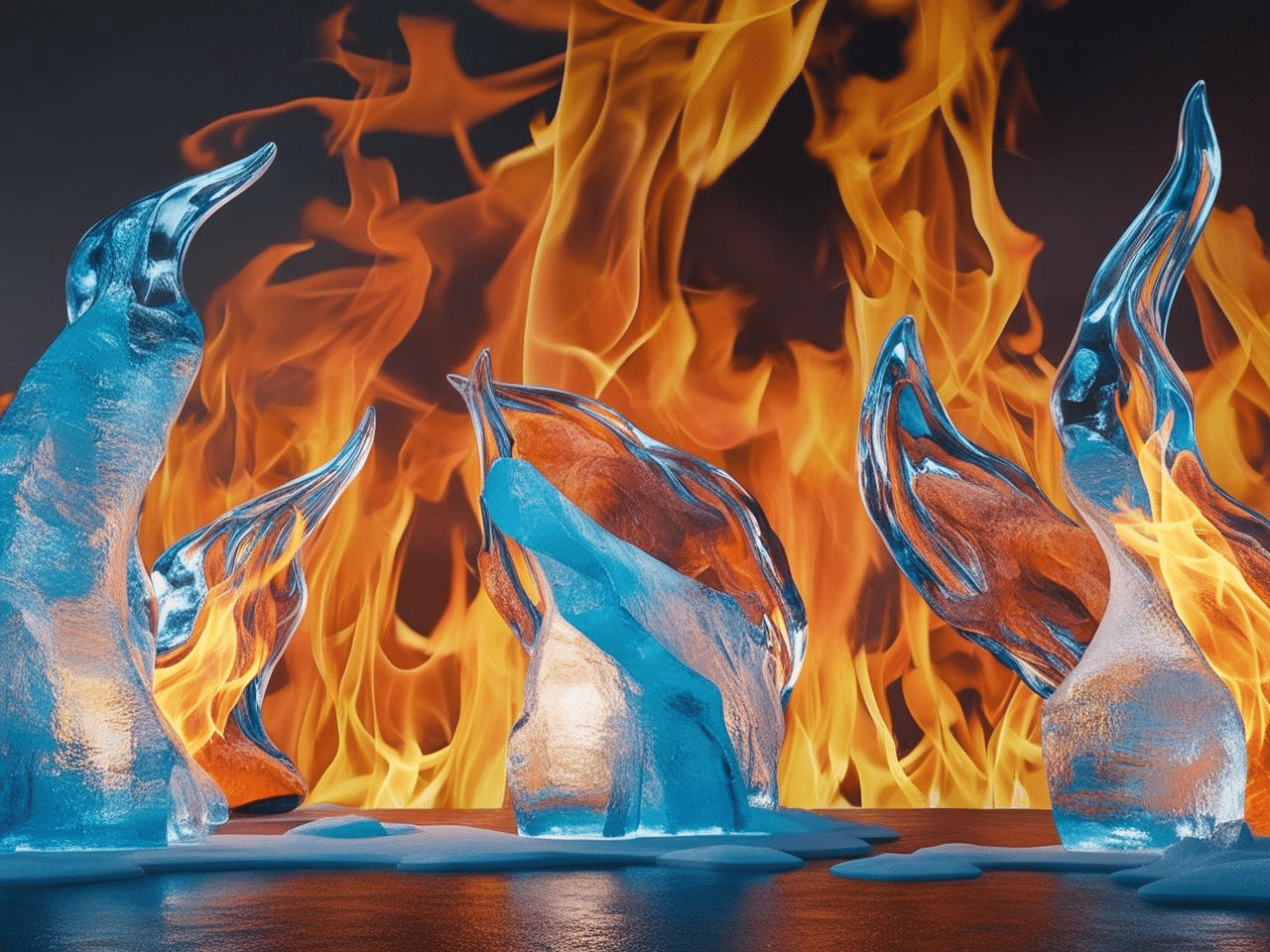Class 10 English Chapter 1 Extract Based Question Answers - First Flight
| Table of contents |

|
| MCQs - Stanza 1 |

|
| MCQs - Stanza 2 |

|
| More Questions on Stanza 1 |

|
| More Questions on Stanza 2 |

|
MCQs - Stanza 1
Read this stanza and answer the following questions:"Some say the world will end in fire
Some say in ice.
From what I've tasted of desire
I hold with those who favour fire."
Q1: What do some people think about how the world will end?
(i) They think the world will end in floods.
(ii) They think the world will end in fire or ice.
(iii) They think the world will end in a storm.
(iv) They think the world will end in an earthquake.
Ans: (ii) They think the world will end in fire or ice.
Solution: The poet mentions that there are two opposing views about how the world will end – one says it will end in fire and the other says in ice.
 Fire and Ice
Fire and Ice
Q2: What is the poet's opinion about desire?
(i) Desire is the cause of destruction.
(ii) Desire should be controlled.
(iii) Desire is not harmful.
(iv) Desire is the force that saves the world.
Ans: (i) Desire is the cause of destruction.
Solution: The poet connects fire with desire and suggests that desire, if left unchecked, can lead to destruction.
Q3: What does "fire" symbolize in the poem?
(i) Heat
(ii) Anger
(iii) Desire
(iv) Rage
Ans: (iii) Desire
Solution: In the poem, fire symbolizes desire, representing intense feelings or passions that can be destructive.
Q4: What is the rhyme scheme of the stanza?
(i) AABB
(ii) ABAB
(iii) ABAA
(iv) ABBA
Ans: (iii) ABAA
Solution: The rhyme scheme of the stanza is ABAA, as the rhyming words "fire" (A), "ice" (B), "desire" (A), and "fire" (A) follow this pattern.
Competency-Based Question
Q5: The poet relates "fire" to desire. If you were in a leadership role, how would you ensure that intense ambition (desire) does not harm your team?
(i) Encourage healthy competition and open communication
(ii) Let ambition run unchecked to boost productivity
(iii) Avoid setting goals to reduce pressure
(iv) Assign individual tasks only and avoid collaboration
Ans: (i) Encourage healthy competition and open communication
Competency Tested: Leadership, Emotional Intelligence
Like "fire," unchecked desire can be destructive. Good leaders channel ambition constructively.
Q6: The poem explores how strong emotions can lead to destruction. How can this idea be applied to real-life conflict management?
(i) Ignore emotional tension and focus on results
(ii) Promote emotional awareness and mediation
(iii) Allow conflicts to escalate to teach lessons
(iv) Avoid working with people who disagree with you
Ans: (ii) Promote emotional awareness and mediation
Competency Tested: Conflict Resolution, Emotional Awareness
Just as the poem warns about the destructive power of emotions, effective conflict management relies on understanding and addressing them.

MCQs - Stanza 2
Read this stanza and answer the following questions:"But if it had to perish twice,
I think I know enough of hate
To say that for destruction ice
Is also great And would suffice."
Q1: What does "it" refer to in the first line?
(i) Fire
(ii) Ice
(iii) Destruction
(iv) The world
Ans: (iv) The world
Solution: "It" refers to the world, which the poet is discussing in terms of its potential end through either fire or ice.
Q2: What is "ice" symbolic of in the poem?
(i) Cold
(ii) Hatred
(iii) Indifference
(iv) Love
Ans: (ii) Hatred
Solution: In the poem, ice symbolizes hatred, representing negative emotions like anger and coldness that can also lead to destruction.
Q3: Which two elements does the poet consider as sufficient to destroy the world?
(i) Fire and ice symbolizing hatred and desire
(ii) Fire and ice symbolizing heat and glaciers
(iii) Fire and ice symbolizing anger and frustration
(iv) The cold attitude and anger of people
Ans: (i) Fire and ice symbolizing hatred and desire
Solution: The poet considers fire (desire) and ice (hatred) as the two destructive forces that can bring about the world's end.
Q4: What is the rhyme scheme of this stanza?
(i) ABABA
(ii) ABABB
(iii) AABBA
(iv) ABBA
Ans: (i) ABABA
Solution: The rhyme scheme of this stanza is ABABA, with the rhyming words "twice" (A), "hate" (B), "ice" (A), "great" (B), and "suffice" (A).
Competency-Based MCQs
Q5: The poet considers “ice” (hatred) as equally destructive. What real-world behavior best reflects controlling such emotions?
(i) Expressing anger immediately to release tension
(ii) Avoiding people who upset you completely
(iii) Practicing empathy and seeking understanding
(iv) Keeping all emotions bottled up
Ans: (iii) Practicing empathy and seeking understanding
Competency Tested: Emotional Regulation, Empathy
Ice represents hate or cold indifference; the antidote is warmth and understanding.
Q6: According to the poem, both desire and hatred can destroy. In terms of decision-making, what’s the best approach to avoid being swayed by such extremes?
(i) Trust only your gut instincts
(ii) Make impulsive choices based on passion
(iii) Balance emotion with reason and consider consequences
(iv) Avoid taking any decisions to stay safe
Ans: (iii) Balance emotion with reason and consider consequences
Competency Tested: Critical Thinking, Decision-Making
Balancing emotions like desire and hate with logic leads to better outcomes, unlike the destructive forces in the poem.
More Questions on Stanza 1
Read this stanza and answer the following questions:Some say the world will end in fire
Some say in ice
From what I’ve tasted of desire
I hold with those who favour fire.
(i) Name the poem and the poet.
Ans: These lines have been taken from the poem ‘Fire and Ice’ composed by Robert Frost.
(ii) What are the two destructive forces?
Ans: ‘Fire’ and ‘Ice’ are two destructive forces according to the poet.
(iii) What do they stand for?
Ans: ‘Fire’ stands for ‘desire’ and ‘Ice’ stands for ‘hatred’.
(iv) What does he favour?
Ans: Robert Frost supports the view that fire would cause the destruction of the world.
More Questions on Stanza 2
Read this stanza and answer the following questions:But if it had to perish twice,
I think I know enough of hate
To say that for destruction ice
Is also great And would suffice.
(i) What does ‘Ice’ stand for?
Ans: Ice stands for hatred in this poem.
(ii) What does the poet believe?
Ans: Robert Frost believes that Ice is equally destructive and can destroy the world.
(iii) What is the another destructive force?
Ans: Fire is another destructive force.
(iv) Find a word in these lines that means opposite to ‘creation’.
Ans: ‘Destruction’.
|
61 videos|620 docs|69 tests
|
FAQs on Class 10 English Chapter 1 Extract Based Question Answers - First Flight
| 1. What are the main themes explored in Robert Frost's poem "Fire and Ice"? |  |
| 2. How does Robert Frost use symbolism in "Fire and Ice"? |  |
| 3. What is the tone of the poem "Fire and Ice"? |  |
| 4. What is the significance of the poem's structure in "Fire and Ice"? |  |
| 5. How does "Fire and Ice" reflect Robert Frost's views on human nature? |  |

















